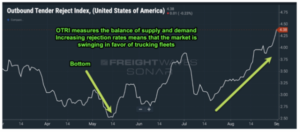Emerging freight data suggests that the trucking market has been gradually strengthening since hitting a low in mid-May. Key freight metrics that track supply and demand dynamics, such as tender rejection rates, indicate improved market conditions that could lead to a stronger second half of 2023 for motor carriers compared to last year.

Freightwaves.com
The data reflects a market rebalancing as overcapacity from the pandemic-driven freight boom starts to ease. Though excess capacity persists, new carrier additions have declined, pointing to gradually tightening supply dynamics. If this capacity correction continues as expected, it could accelerate freight rate increases, perhaps as early as late 2023 but more likely in 2024.
According to freight market cycles, larger asset-based carriers may be the biggest beneficiaries of the recovery. As volumes rebound, large carriers are typically the last impacted by downturns and the first to see improving conditions. Smaller carriers still face overcapacity.
For brokers, spreads between contract and spot rates remain near historically wide levels. This suggests potential margin compression ahead as contract rates eventually catch up to the spot market. Highly leveraged brokers who relied on cheap debt to finance rapid growth could face financial pressure. Some may struggle to meet debt agreements.
To get ahead of potential volatility, shippers should take steps like benchmarking rates using detailed freight data, locking in longer-term contract rates, and considering indexed contracts that can automatically adjust to market swings. Being data-driven will help shippers secure capacity and manage risks during the 2024 bid season when conditions could be tighter.
Comprehensive freight market data spanning all modes enables logistics managers to closely analyze trends, scenarios, accurately forecast future rates and capacity, and make strategic decisions. Leveraging data analytics becomes even more critical for shippers.
In summary, recent freight metrics suggests trucking market conditions have modestly improved from rock bottom after an extended downturn. Carriers appear poised to strengthen in the near term, while shippers face risks of rate increases and volatility. By getting ahead of the market now with data, contracts, and pricing models, shippers can add resilience to their supply chains.


